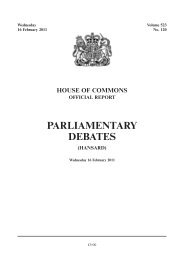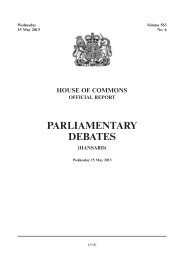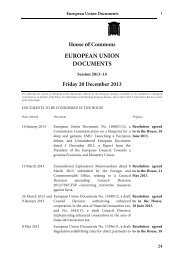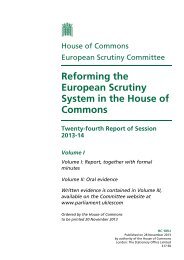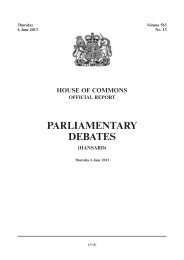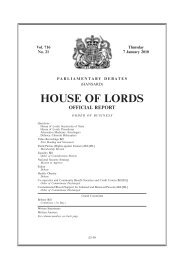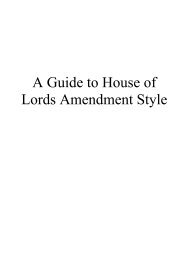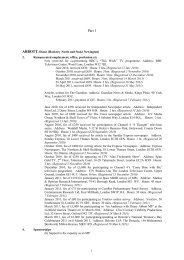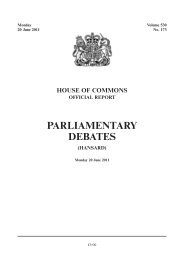View PDF - United Kingdom Parliament
View PDF - United Kingdom Parliament
View PDF - United Kingdom Parliament
Create successful ePaper yourself
Turn your PDF publications into a flip-book with our unique Google optimized e-Paper software.
153W<br />
Written Answers<br />
26 OCTOBER 2009<br />
Written Answers<br />
154W<br />
We are not able to provide the breakdown of costs by<br />
publication as we use so many that we would incur<br />
disproportionate cost in trying to identify each individual<br />
publication listed in the spend data files.<br />
Employment and Support Allowance<br />
Danny Alexander: To ask the Secretary of State for<br />
Work and Pensions (1) what the average time taken to<br />
process (a) an employment support allowance (ESA)<br />
claim where a medical certificate was required and (b)<br />
an ESA claim where a repeat or duplicate request for a<br />
medical certificate was made was in the latest period<br />
for which figures are available, broken down by benefit<br />
delivery centre; [293414]<br />
(2) how many requests have been made for medical<br />
certificates for the purpose of processing employment<br />
support allowance (ESA) claims in the most recent<br />
period for which figures are available; and how many<br />
duplicate or repeat requests have been made for<br />
medical certificates for the purpose of processing ESA<br />
claims, broken down by benefit delivery centre in each<br />
case. [293425]<br />
Jonathan Shaw: The administration of Jobcentre Plus<br />
is a matter for the acting chief executive of Jobcentre<br />
Plus, Mel Groves. I have asked him to provide the hon.<br />
Member with the information requested.<br />
Letter from Mel Groves:<br />
The Secretary of State has asked me to reply to your questions<br />
asking what the average time taken to process (a) an Employment<br />
and Support Allowance (ESA) claim where a medical certificate<br />
was required and (b) an ESA claim where a repeat or duplicate<br />
request for a medical certificate was made in the latest period for<br />
which figures are available, broken down by benefit delivery<br />
centre; and how many requests have been made for medical<br />
certificates for the purpose of processing Employment and Support<br />
Allowance claims in the most recent period for which figures are<br />
available; and how many duplicate or repeat requests have been<br />
made for medical certificates for the purpose of processing ESA<br />
claims, broken down by benefit delivery centre in each case. This<br />
is something which falls within the responsibilities delegated to<br />
me as Acting Chief Executive of Jobcentre Plus.<br />
Performance against our average processing time targets are<br />
published on the Jobcentre Plus external website. The clearance<br />
times for Employment and Support Allowance are not yet part of<br />
Jobcentre Plus’s targets. They will form part of the published<br />
target suite from April 2010 and will be placed on the website<br />
shortly afterwards.<br />
The reason for the delay in publishing the official figures is<br />
because it is necessary for Jobcentre Plus to first collect an<br />
appropriate amount of performance data with which to inform<br />
and set a relevant target level.<br />
We are currently exploring whether we can develop some<br />
official statistics on processing times for Employment and Support<br />
Allowance new claims in the near future.<br />
Jobcentre Plus does not collate any information on requests for<br />
medical certificates so. we are unable to supply the information<br />
requested with relevance to this element.<br />
Mr. Harper: To ask the Secretary of State for Work<br />
and Pensions how many and what proportion of those<br />
who stopped claiming employment and support<br />
allowance before their assessment was completed were<br />
(a) in work, (b) claiming jobseeker’s allowance (JSA)<br />
and (c) not recorded as being in work or claiming JSA<br />
up to the end of August 2009. [294741]<br />
Jim Knight [holding answer 21 October 2009]: The<br />
information is not available in the form requested.<br />
However, statistics published last week showed that<br />
between October 2008 and February 2009 38 per cent of<br />
new claimants to employment and support allowance<br />
stopped claiming benefit before the work capability<br />
assessment in their case was completed.<br />
Employment Schemes<br />
Mr. Harper: To ask the Secretary of State for Work<br />
and Pensions what the eligibility criteria are for individuals<br />
seeking to be referred to (a) Workstep, (b) the Job<br />
Introduction Scheme and (c) Work Preparation.<br />
[295028]<br />
Jonathan Shaw [holding answer 22 October 2009]: To<br />
be eligible for Workstep an individual must be disabled,<br />
as defined by the Disability Discrimination Act 1995.<br />
This Act defines a disabled person as someone who has<br />
’a physical or mental impairment which has a substantial<br />
and long-term adverse effect on his/her ability to carry<br />
out normal day to day activities’. In addition, Workstep<br />
customers must also fall within one of the Workstep<br />
eligibility codes. This information is in the following<br />
table:<br />
Code<br />
A<br />
B<br />
C<br />
D<br />
E<br />
F<br />
G<br />
Details<br />
Workstep eligibility codes<br />
On incapacity benefit/severe disablement allowance/national<br />
insurance credits only and/or income support, or on employment<br />
and support allowance<br />
On jobseeker’s allowance and/or national insurance credits<br />
only, for six months or more in a current or ’linked’ job<br />
seeking period<br />
On jobseeker’s allowance, and/or national insurance credits<br />
only, for less than six months but have been in receipt of<br />
incapacity benefit or employment and support allowance,<br />
immediately before claiming jobseeker’s allowance<br />
A former supported employee who has progressed but needs<br />
to return to the programme within two years or has left for<br />
any other reasons and returns within one year<br />
Currently in work but at serious risk of losing their job as a<br />
result of disability, even after the employer has made all<br />
reasonable adjustments and considered other available support<br />
options<br />
A recent/prospective education leaver who does not fall within<br />
Codes A to E above, but for whom there is clear evidence of a<br />
need for support in work<br />
A customer who has been granted access to Workstep through<br />
a discretionary decision, where a full business case has been<br />
sent to the Jobcentre Plus district third party provision manager<br />
and approval has been granted<br />
H<br />
A customer who is receiving a war disablement pension or<br />
help from the Armed Forces Compensation Scheme<br />
Note:<br />
Two or more job seeking periods can be ‘linked’ and treated as one if they are<br />
separated only by: a linked period (for any length of time) comprising incapacity<br />
benefit, invalid care allowance, maternity allowance or training allowance; a<br />
break in an individual’s claim, where the claim is terminated for not more than<br />
12 weeks between any two linked job seeking periods; any length of time spent<br />
on jury service.<br />
Source:<br />
Jobcentre Plus Workstep Programme Guidance, Chapter 3, Eligibility and<br />
Referrals.



